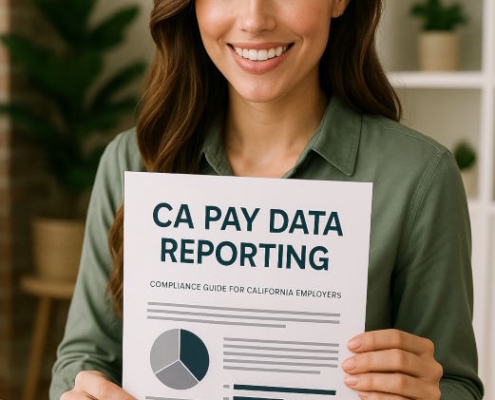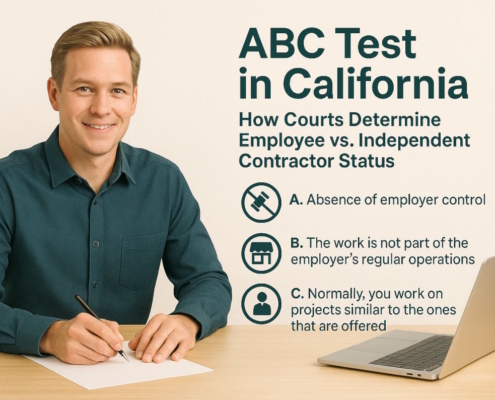4. Does an Inappropriate Email or Letter Count as Sexual Harassment?
Sometimes, employees will exchange sexually inappropriate material in workplace emails. While this is inadvisable, it only counts as sexual harassment if the behavior is unwelcome. If an employee is the unintended recipient of an email or that includes nudity, sexual comments, sexually charged material, related or not to anyone in the workplace, then the receiver could be the victim of sexual harassment. This is the case even if the sender did not intend for the recipient to receive the email or letter. An employee should not have to put up with any uncomfortable or unwelcome sexual material in the workplace. Under California’s Fair Employment and Housing Act, it is an employer’s legal obligation to ensure a safe and harassment-free workplace. Therefore, it is important to tell one’s employer about any sexually offensive conduct.
Example: One day at the office, Keira receives an email from her coworker, Justin. The email is addressed to another colleague, Kevin, and the subject concerns a topic of a sexual nature. Feeling very uncomfortable, Keira approaches Justin about it, and he apologizes but says that she shouldn’t be upset since it wasn’t meant for her. However, in this situation Keira is the victim of indirect sexual harassment, because the email made her feel uncomfortable. She has the right not to be exposed to sexual material at work.
5. Does an Inappropriate Poster Count as Sexual Harassment?
Many workplaces allow their employees to decorate their personal workspaces with posters, flyers, or pictures. That said, if an employee or manager posts a sexually inappropriate picture or poster in their cubicle, on their desk, or in their office, this qualifies as sexual harassment. An employee has the right to a workplace free of visual or written sexual material. Visible posters containing sexual imagery or messages may be seen as sexual harassment toward individuals who unintentionally see them.
Example: One day, Jonathan walks into his boss’ office to ask about a project. He finds a sexually explicit poster on the wall, and he has to sit beneath it while talking to his boss. Jonathan feels uncomfortable being exposed to this kind of inappropriate material at work. Even though the poster is not there to target him, it nevertheless has a negative impact on him. As a result, he is a victim of indirect sexual harassment and has the right to file a complaint.
6. Do Obscene Gestures Count as Sexual Harassment?
While humor is acceptable and even welcome in the workplace, sexually explicit humor can make people feel uncomfortable. Sexually explicit humor includes sexual sounds or gestures. This manner of gestures and comments qualifies as sexual harassment under California and federal law. If an employee hears a manager or other employee make offensive gestures or sounds in the workplace, he or she could be the victim of sexual harassment. The employee should make their objection politely but clearly heard and then record their objection to the harassment in writing.
Example: One day, Joanna is sitting in her cubicle doing an expense report. She hears noise coming from the adjacent cubicle where her colleague, Louis, works. Louis is talking to their coworker, Hank, about a sexual exploit. The sound Joanna hears is sexual in nature, and the men are laughing about it. Joanna leans around the cubicle to ask them to stop and she witnesses Louis make a sexual gesture at Hank. Though both apologize to Joanna, she still feels uncomfortable. She is a victim of indirect sexual harassment, because even though the explicit sound and gesture were not directed at her, they still made her feel uncomfortable.
7. Does Talking About Sexual Activity Count as Sexual Harassment?
While it is normal in America to converse with colleagues at the workplace, conversation must not involve hostile or unwelcome discussion of a sexual nature. In the past, sexually themed conversations in the workplace were often dismissed as “water cooler” talk and not harassment. However, in the case of Mogilefsky vs. Silver Pictures, a precedent was set, making sexually explicit conversation harassment under the California Fair Employment and Housing Act.
Employees in California have the right to work in safe environment that does not feature conversations involving sexual innuendo or explicit topics. If a coworker or manager constantly has conversations about sexual activity or interests, an employee could be the victim of sexual harassment. This is true even if the employee was not a party of the conversation, but simply overheard it. It is important, again, that the employee make their discomfort apparent by recording the content of the conversation in writing.
Example: One day, Alex sees his coworkers, Greg and Lars, talking around the water cooler. Thinking that they’re talking about sports, he goes over to join them. However, he quickly realizes that they are having a discussion of a sexual nature. Alex feels uncomfortable when they try to engage him in conversation about the subject. Alex also notices a female employee covering her ears at her desk, looking disturbed. Both Alex and the female employee, being unwilling witnesses of the sexually explicit discussion, are victims of indirect sexual harassment.
8. Does Commenting on Other Employees Count as Sexual Harassment?
The Mogilefsky case also set another precedent, establishing that sexual harassment does not imply sexual attraction. Sexual harassment can also include hostile sexual conduct. This kind of harassment may be considered a form of bullying in the workplace. Perhaps an employer or employee uses a sexual slur or makes a comment about another employee’s body. An employee who overhears this kind of talk, whether or not they are the person being talked about, is a victim of sexual harassment. They are having to endure unwelcome sexual comments in the workplace, and this behavior should be documented.
Example: One day at work, Elise walks into the kitchen to find two other coworkers, Hannah and Yara, talking about another female colleague. They are using sexual slurs to describe her and are talking about her body in a rude way. Elise is friends with the victim of this talk, and she feels uncomfortable listening to it. As a witness to this inappropriate conversation, Elise is a victim of indirect sexual harassment. She writes down the conversation as she heard it and reports it to human resources.
9. Does Witnessing the Sexual Harassment of Another Employee Count as Sexual Harassment?
If an employee witnesses the sexual harassment of others, then he or she is, in fact, a victim of indirect sexual harassment. This is one of the most common cases of sexual harassment in a hostile work environment. In this situation, an employee will witness a supervisor or colleague sexually harass another employee. Witnessing this sexual harassment can make the employee feel uncomfortable and as though they themselves are harassed. A hostile environment where sexual harassment is so prevalent and noticeable can make safety a concern for everyone. It may also bother an employee to know that they work in a place where sexual harassment is tolerated. It may also concern the employee that if the abuser discovers their knowledge of the harassment, the employee may face retaliation or firing. Still, if the conduct is offensive, then it is important for the witness to report the behavior to human resources or an appropriate supervisor.
Example: One day at work, Adam walks into the corridor to find his supervisor invading the personal space of a coworker, Jane. The supervisor is putting his hand around her waist, trapping her against the wall, and whispering in her ear. Adam notices that jane is grimacing and trying to get away. Afraid of getting in trouble for witnessing this, Adam walks into the office. He feels uncomfortable about what he just witnessed. In fact, as a witness of Jane’s sexual harassment, Adam himself is a victim of indirect sexual harassment.
10. What Are the Laws Governing Sexual Harassment?
In California, sexual harassment is strictly against the law. Sexual harassment is also unlawful under federal law, as it is addressed in Title VII of the Civil Rights Act of 1964. The Equal Employment Opportunity Commission (EEOC) defines harassment as behavior that is unwelcome based on race, color, religion, sex, national origin, disability, age, or genetic information.
In California specifically, the Fair Employment and Housing Act (FEHA) and the California Constitution prohibit sexual harassment. Also, California’s Labor Code demands that employers do whatever possible to ensure a safe workplace free of harassment.
11. What to do if you have been sexually harassed
Under California and federal law, employees are protected from being sexually harassed. This also includes indirect sexual harassment. It is common for an individual to feel as if their claim is not as string because they themselves were not targeted. Instead, they were indirectly affected by the harassment. However, an employee has the legal right to work in a safe environment free of harassment, even if the harassment is not aimed at them specifically.
It is still important for an employee to communicate their discomfort to a supervisor or employer. Employee handbooks will detail the proper protocol, describing how to file a complaint with human resources. One should remember to voice concerns in a polite but firm manner. It is not wise to suddenly resign or have an angry outburst. One should instead consider taking leave to calm one’s head.
In sum, if an employee feels uncomfortable, harassed, violated, or threatened because of another’s inappropriate and unwelcome behavior in the workplace, he or she has the legal right to file a sexual harassment suit. This is true even for those who are indirect victims of the harassment.























